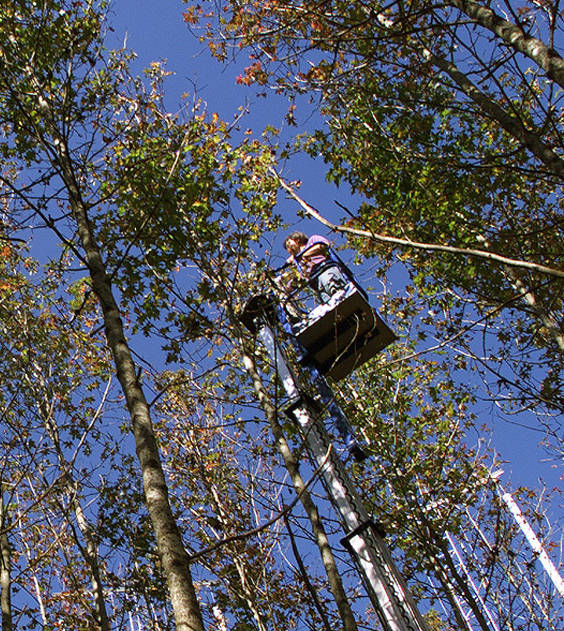August 13, 2021
The Shape of Future Forests
Twelve years of CO2 enrichment in a sweetgum forest did not alter forest stand and canopy development.

Using a hydraulic lift, an investigator measures canopy structure in a sweetgum forest as part of the Oak Ridge free-air CO2 (FACE) experiment conducted from 1997 to 2010.
[Courtesy Oak Ridge National Laboratory.]
The Science
Trees display their leaves so that the forest canopy can best make use of critical environmental resources, including light, carbon, water, and nitrogen. As a forest grows and develops, the forest’s structure and canopy also change. Researchers observed these changes during a 12-year experiment in a sweetgum forest growing in an atmosphere enriched with CO2 concentrations that will occur in the future. Although growth in elevated CO2 can alter the use of other resources, this young forest showed little evidence that elevated CO2 altered tree and stand development or canopy structure.
The Impact
An important need for understanding how forests will function under future atmospheric CO2 levels is how mature and diverse forests will respond to elevated CO2. Future studies should address how changes in canopy structure can affect how forests will respond to drought and infertile soils. This study engaged many questions about whether a more diverse, mixed species forest would respond similarly to the young, single-species stand. Results showed the likely value of including more detailed descriptions of canopy structure in models.
Summary
Canopy structure—the size and distribution of tree crowns and the spatial and temporal distribution of leaves within them—exerts dominant control over primary productivity, transpiration, and energy exchange. Stand structure—the spatial arrangement of trees in the forest (height, basal area, and spacing)—has a strong influence on forest growth, allocation, and resource use. Forest response to elevated atmospheric CO2 is likely to be dependent on canopy and stand structure. Scientists investigated elevated CO2 effects on forest structure of a sweetgum (Liquidambar styraciflua) stand in a free-air CO2 enrichment (FACE) experiment, considering leaves, tree crowns, forest canopy, and stand structure. During the 12-year experiment, the trees increased in height by 5 m, and basal area increased 37%. Basal area distribution among trees shifted from a relatively narrow distribution to a much broader one, but little evidence emerged regarding an effect of CO2 on height growth or basal area distribution. The differentiation into crown classes over time led to an increase in the number of unproductive intermediate and suppressed trees and a greater concentration of stand basal area in the largest trees. A whole-tree harvest at the end of the experiment permitted detailed analysis of canopy structure. Results showed little effect of CO2 enrichment on the relative leaf area distribution within tree crowns and little change from 1998 to 2009. Leaf characteristics (leaf mass per unit area and nitrogen content) varied with crown depth; any effects of elevated CO2 were much smaller than the variation within the crown and were consistent throughout the crown. This young, even-aged, monoculture plantation forest not only showed little evidence that elevated CO2 accelerated tree and stand development but also demonstrated remarkably small changes in canopy structure.
Principal Investigator
Richard Norby
Oak Ridge National Laboratory; University of Tennessee, Knoxville
rnorby@utk.edu
Program Manager
Brian Benscoter
U.S. Department of Energy, Biological and Environmental Research (SC-33)
Environmental System Science
brian.benscoter@science.doe.gov
Funding
This work was funded by the FACE Model-Data Synthesis project by the Biological and Environmental Research (BER) Program in the U.S. Department of Energy’s (DOE) Office of Science.
Related Links
References
Norby, R. J., et al. "Forest Stand and Canopy Development Unaltered by 12 Years of CO2 Enrichment." Tree Physiology 42 (3), 428–440 (2022). https://doi.org/10.1093/treephys/tpab107.

